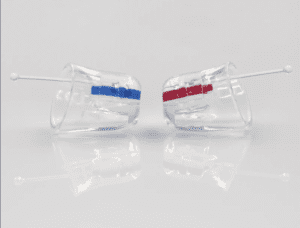 People with autism, ADHD, auditory processing disorder, or a history of trauma often struggle with hypersensitivity to sound, known as hyperacusis, as well as difficulties understanding speech in noisy environments due to auditory figure-ground issues. For students, these challenges can be particularly difficult, as schools are typically filled with loud sounds and noisy situations that can be overwhelming.
People with autism, ADHD, auditory processing disorder, or a history of trauma often struggle with hypersensitivity to sound, known as hyperacusis, as well as difficulties understanding speech in noisy environments due to auditory figure-ground issues. For students, these challenges can be particularly difficult, as schools are typically filled with loud sounds and noisy situations that can be overwhelming.
What is Hyperacusis?
Hyperacusis is a condition in which a person becomes overly sensitive to certain sounds or environments with prevalent noise. In a school setting, this could manifest when a bell rings, a child suddenly screams, or there is a loud, unexpected sound, like something crashing to the floor. Some children may have trouble in any noisy setting, such as during recess on the playground, classroom parties, or music lessons. In public spaces like restaurants or the mall, sounds echo off hard surfaces which can cause a lot of discomfort.
When a person experiences hyperacusis, their response to these sounds often includes irritability, anger, or distress. Some children may react by running off or even hitting those nearby when a sudden loud noise occurs. One common cause of hyperacusis is a history of frequent ear infections. Another common cause is a history of complex trauma, which a trauma therapist can help you overcome. In some cases, the sensitivity may lessen as the person ages, or it can be managed with therapies such as auditory training or listening exercises. Safe and Sound Protocol is one such listening therapy, which stimulates the nerve and calms the auditory system.
What are Auditory Figure-Ground Issues?
Auditory figure-ground issues refer to the difficulty some individuals have when trying to distinguish between background noise and the foreground sounds they want to focus on, such as a conversation. Typically, the brain is able to filter out distracting sounds and focus on what’s important, but for people with auditory figure-ground challenges, this becomes nearly impossible. To them, all sounds have the same volume, making it hard to concentrate on one sound while filtering out others.
This difficulty in separating sounds makes understanding conversations in noisy environments incredibly taxing. The person has to work much harder to follow what is being said, leading to exhaustion and frustration, especially in loud settings like classrooms.
A Simple Solution: Musician’s Ear Filters
I discovered a simple yet effective solution: Earasers, musician’s ear filters. Originally designed for musicians to protect their hearing during rehearsals and performances, these filters work by muting loud noises while allowing moderate sounds to pass through. This technology reduces the impact of overwhelming sounds but still enables the user to hear important sounds, like a bandmate’s voice.
These filters turned out to be incredibly helpful for my son. They reduced the intensity of disturbing sounds while allowing him to hear conversations and instructions clearly. Earasers are easy to insert and remove, and they are discreet, so no one even notices when a child is wearing them.
Why Earasers are a Great Option
While there are custom-made ear filters available through audiologists, which can cost thousands of dollars, Earasers offer an affordable and effective alternative at just around $40. They’re a straightforward solution to a complex issue, and they can be a great starting point to determine if this type of auditory support might help your child. If you’re considering custom ear filters, trying Earasers first may help you decide if this approach is right for your child.
Where to Buy Earasers
Earasers can be purchased from Amazon or music stores like Guitar Center. The company offers a size guide to help you choose the right fit, and they also provide a 30-day money-back guarantee if you find they don’t work for your child.